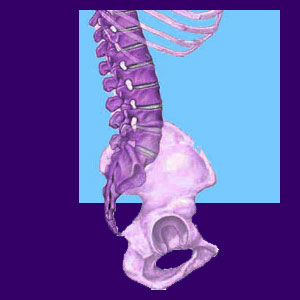
The lumbar spine is the region of the back in between the thoracic spine and the sacrum. There are 5 lumbar vertebrae named L1 through L5. This lower region of the spine has a lordotic curve and is designed for weight bearing, as well as flexibility.
The intervertebral discs in the lower spine receive the most use and abuse of any in the body. Degenerative disc disease is a virtually universal occurrence in the lowest lumbar discs by the age of 30 and often far younger.
Normally, the spinal cord ends at the L2 vertebra, but it may end as high as T12 or as low as L3. The auda equina is the group of nerves that continue from the base of the spinal cord through the lower lumbar and sacral spinal regions.
This essay profiles the lumbar region of the human vertebral column, including its tendency to be the primary location for chronic back pain to exist.
Lumbar Spine Abnormalities
The lumbar and lumbosacral spinal regions are the areas most likely to develop a variety of possibly pathological structural issues. However, many of these conditions may be completely innocent in their minor forms.
Herniated discs are commonplace, especially at L4/L5 and L5/S1.
Spondylolisthesis occurs most often at vertebral level L5.
Hypolordosis and hyperlordosis are seen in the lumbar region in a significant percentage of the population.
Sometimes a person is born with an L6 vertebra, also called a transitional vertebra. This condition is usually harmless and rarely causes any problems. In other cases, a sacralized vertebra might exist, in which the lowest lumbar level, usually L5, is fused to the sacrum. Once again, this is usually an asymptomatic occurrence, but some doctors theorize this to be a pain generating mechanism for a select group of unfortunate patients.
Lumbar Pain Epidemic
The lumbar region of the spine is not a fragile structure, contrary to popular belief. It is rugged, durable and designed to take a lifetime of abuse. Modern medicine has created a nocebo effect on our view of the lower back. Over seventy years ago, lower back pain was uncommon. Now it is the #2 problem requiring a doctor visit and the #1 reason for a person to miss work. The lumbar back pain epidemic is no joke.
Sure, it is a fact that the lumbar region certainly takes its fair share of abuse. Deterioration of the area is normal and expected and a variety of abnormalities have a tendency of developing. However, it is crucial to understand that there has been a tremendous number of research studies completed on low back pain and none show definite links between mild to moderate forms of the most common spinal irregularities and the expression of painful symptoms.
There are many doctors who believe that most low back syndromes are not structurally-induced , but are, instead, are just another of the effects of the mindbody process.
For patients who are interested in learning more about this type of nonstructural pain theory, consider researching tension myositis syndrome and its most famous champion, Dr. John E. Sarno.




